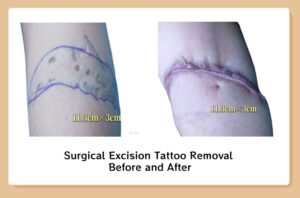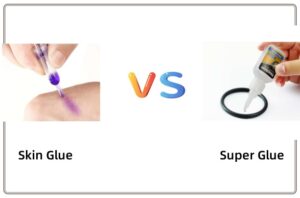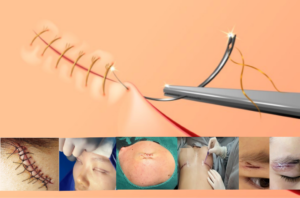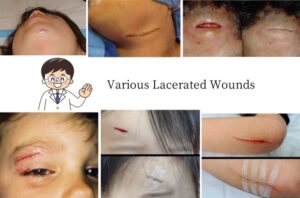In medical procedures, the correct application of surgical glue is essential to ensure patient safety and achieve optimal wound healing.
This article uses a real surgical video to explain the correct and incorrect use of surgical adhesives and the impact they bring.
In the video, when the surgeon uses surgical adhesive, he first squeezes the glue into the wound and then uses tweezers to clamp the skin edges on both sides to close the surgical incision. This operation is obviously wrong; glue squeezed into the wound may cause infection and a foreign body reaction! It may also hinder normal tissue healing and form dead space.
- Clean and Dry the Wound: Use alcohol or saline to remove debris and ensure the surface is moisture-free.
- Align Skin Edges Gently: Avoid excessive tension; manually position the wound edges without tools to prevent trauma.
- Apply Adhesive Sparingly: Dab a thin layer on the skin’s external surface, not inside the wound.
- Hold Steady Until Initial Bonding: Maintain light pressure for 15–30 seconds to allow the adhesive to form a secure bond.
- Avoid Post-Application Disturbance: Let the adhesive cure fully (24–48 hours) before exposing the area to water or friction.
Correct use of surgical glue can bring the following benefits:
1. Quickly close the wound and reduce the risk of infection.
- After the correct application, the glue quickly solidifies within 10–20 seconds to form an antibacterial barrier (cyanoacrylate component), isolate external bacteria, and reduce the probability of infection.
2. Align the skin and make the scar smaller.
- Align the skin edge first and then apply glue, which can reduce tension scars (such as centipede scars). After healing, the surface will be smooth, improving the appearance.

3. No need to remove stitches, reducing the burden on patients
- Compared with traditional sutures, glue closure does not require secondary suture removal, reducing pain and care costs, especially suitable for children and sensitive parts (such as the face and joints). Need help choosing? See our guide to adhesive tape, stitches, staples, and surgical glue.
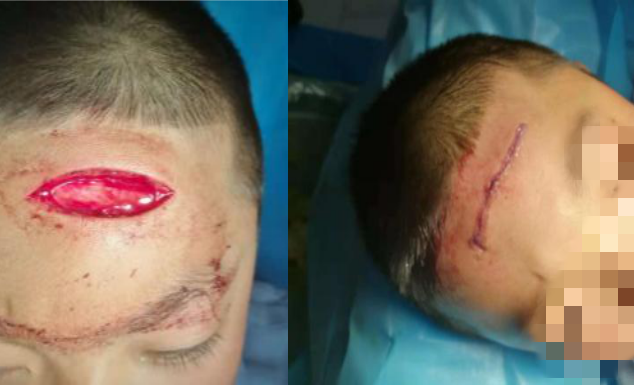
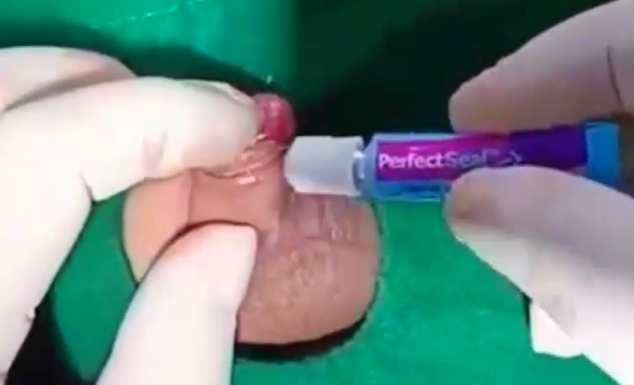
Surgical skin glue to seal the child’s forehead wound
PerfectSeal skin adhesive glue to seal circumcision surgical incisions
4. Waterproof and breathable, accelerating healing
- Surgery glue forms a flexible protective film, which is waterproof and allows the skin to breathe, avoiding wound cracking after soaking, and promoting a natural healing environment.
5. Convenient operation and reduced medical costs
- Medical staff can complete closure within 5 minutes, saving surgical time; patients do not need to change dressings frequently, reducing the number of follow-up visits.
6. Reduce postoperative discomfort.
- The glue is soft and has no nodules, reducing friction and stimulation to surrounding tissues and making patients more comfortable in daily activities.
Precautions for Using Surgical Glue Adhesive
Preparation Before Operation
1. Wound assessment
- Only applicable to clean, non-infected, and neatly edged wounds (such as surgical incisions or superficial lacerations), prohibited for use on purulent, necrotic, or deep tissue injuries.
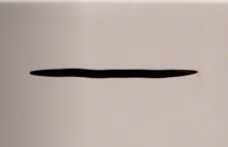
Neatly edged wound
2. Skin treatment
- Thoroughly clean and dry the skin, and ensure complete evaporation of alcohol or iodine tincture after disinfection (to avoid residual liquid that reduces adhesion strength).
3.Allergy Test
- Apply a small amount on healthy skin before first use, and observe for 24 hours for any redness or swelling (especially for those allergic to cyanoacrylate, do not use).
Operational Standards
1. Align the skin
- You must use tweezers/fingers to align the skin on both sides of the wound without tension to avoid misalignment that could cause uneven healing or cracking.
2. Application Method
- Apply 1-2 thin layers along the wound edges, with a width of ≤5mm. Excess glue must be wiped off with a dry gauze within 2 seconds (to prevent it from seeping into the wound).
3. Curing time
- After applying, press for 10-20 seconds until fully cured, avoiding blowing, rubbing, or moving (which may damage the bonding surface).
Post-Operative Care
1. Waterproof protection
- After curing, you can take a normal shower, but prolonged soaking (such as swimming or soaking in a tub) is prohibited. Water temperature should be ≤40℃.
2. Avoid irritation
- Do not tear off the adhesive film before it has healed. If the edges are lifted, use scissors to trim them. Do not forcibly peel it off (as it may cause secondary damage).
3. Observe abnormalities
- If redness, swelling, discharge, or increased pain occurs, seek medical attention immediately (it may be an infection or allergic reaction).
Special Risk Warning
1. Protective measures
- The operator must wear gloves to avoid contact with the eyes or mucous membranes (if contact occurs, rinse with water for 15 minutes and seek medical attention).
2. Environmental Requirements
- Keep away from open flames (glue vapors are flammable) and ensure proper ventilation (to reduce inhalation of volatile gases).
3. Disabled scenarios
- Joint areas, around the mouths of infants and young children, mucous membranes (frequent activity or humid environments can easily cause detachment).
Storage and Expiration Date
- Unopened glue should be stored away from light at temperatures below 25°C.
- Expired or solidified glue is prohibited from use.


